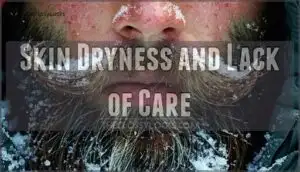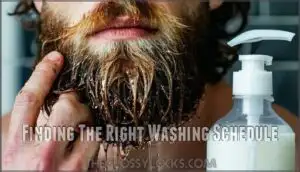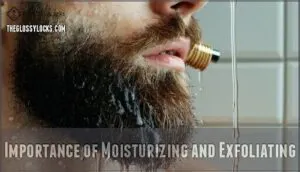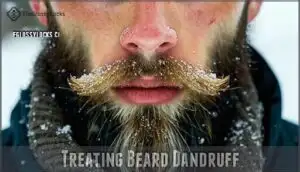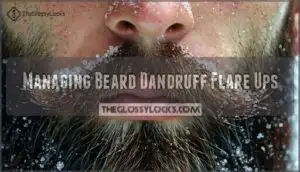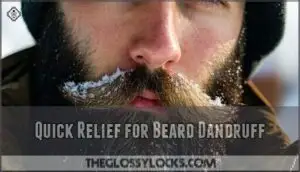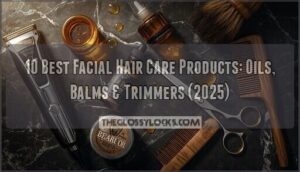This site is supported by our readers. We may earn a commission, at no cost to you, if you purchase through links.
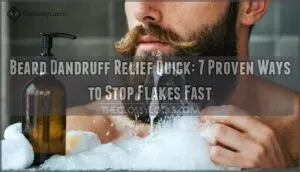
Follow up with a moisturizing beard oil to hydrate the skin underneath. For immediate results, try a diluted apple cider vinegar rinse – mix one part vinegar with two parts water and massage into your beard, then rinse thoroughly.
Exfoliate weekly with a soft brush to remove dead skin cells. Avoid over-washing, which strips natural oils and worsens flaking.
These simple steps tackle the root causes while providing fast comfort. The secret lies in understanding what triggers your specific flare-ups and using the right treatments, such as a diluted apple cider vinegar rinse, to find beard dandruff relief.
Table Of Contents
Key Takeaways
- Start with gentle cleansing – Wash your beard 2-3 times weekly with sulfate-free beard shampoo containing tea tree oil or salicylic acid to remove flakes without stripping natural oils
- Apply beard oil immediately – Use moisturizing beard oil on damp hair after washing to hydrate the skin underneath and prevent future flaking from dryness
- Try apple cider vinegar rinse – Mix one part vinegar with two parts water, massage into your beard, then rinse thoroughly for fast relief from stubborn flakes
- Exfoliate weekly but gently – Use a soft brush to remove dead skin cells once per week, avoiding over-washing, which worsens the problem by stripping protective oils
What is Beard Dandruff
Beard dandruff appears as white flakes trapped in your facial hair, often accompanied by itching and irritation beneath the beard.
You’ll recognize it by the telltale signs of dry, flaky skin that sheds from the area where your beard grows, creating an embarrassing snowfall effect on your shirt.
Common Symptoms and Warning Signs
You’ll notice beard dandruff symptoms appearing gradually, starting with persistent beard itch that worsens throughout the day.
Flaky skin emerges as white or yellowish flakes trapped in your facial hair, while beard redness develops around irritated follicles.
Itchiness severity ranges from mild discomfort to intense scratching urges.
Skin irritation creates tender, inflamed patches beneath your beard.
Hair loss may occur from excessive scratching damaged areas.
How It Differs From Scalp Dandruff
Beard dandruff differs from scalp dandruff in several key ways.
Your facial skin produces less sebum than your scalp, making it more prone to dryness. Hair texture plays a role too—beard follicles are coarser and less dense.
While Malassezia causes both conditions, your skin sensitivity means beard dandruff requires gentler treatment than harsh scalp shampoos.
A common cause is buildup of dead skin, which is a significant factor in beard dandruff development.
Diet, Stress, and Lifestyle Factors
What triggers your beard dandruff beyond just dry skin? Your lifestyle plays a bigger role than you’d think.
Poor nutrition, chronic stress, and inconsistent care routines create the perfect storm for those annoying flakes.
- Nutrient deficiencies in vitamins A, B, zinc affect skin health and beard growth
- Hydration importance can’t be overstated – dehydrated skin sheds more cells
- Stress management reduces inflammation that worsens dandruff conditions
Causes of Beard Dandruff
Understanding what causes beard dandruff helps you tackle the problem at its source rather than just treating symptoms.
You’ll find that most cases stem from two main categories: everyday care issues and underlying medical conditions, which can be considered as complete concepts to understand the root of the problem.
Skin Dryness and Lack of Care
Your dry beard skin craves moisture, but improper beard care routine creates a vicious beardruff cycle.
Winter dryness strips natural oils while harsh products damage your skin’s protective barrier. Without regular beard moisturizing, dead skin accumulates beneath coarse facial hair.
Poor cleansing frequency allows oil buildup to mix with flakes, creating that telltale snowfall on your shirt. You can’t achieve proper beard hydration without understanding your skin’s needs.
Daily beard oil application and gentle cleansing break this cycle, restoring balance to irritated skin underneath your beard. A key factor can be environmental cold weather, which further exacerbates the issue, making proper beard hydration and gentle cleansing crucial for beard care and preventing dryness.
Medical Conditions and Autoimmune Diseases
Sometimes the root of your flaking runs deeper than dry skin.
Seborrheic dermatitis affects up to 50% of adults, creating an autoimmune connection where your immune system overreacts to Malassezia yeast.
Psoriasis triggers include stress and genetics, causing thick, scaly patches that extend beyond your hairline.
Eczema impact varies but creates chronic inflammation from allergens in beard products.
Skin irritation from shaving can also contribute to beard issues.
These autoimmune diseases disrupt normal skin cell turnover, while yeast infections thrive in your beard’s warm, oily environment.
If over-the-counter treatments fail, you’ll need professional diagnosis to tackle the underlying condition.
Preventing Beard Dandruff
Prevention is your first line of defense against beard dandruff, and it’s much easier than treating an active flare-up.
The key lies in establishing a consistent routine that balances cleansing without over-drying your skin.
Finding The Right Washing Schedule
Your skin type determines how often you should wash your beard to prevent beard dandruff.
Oily skin needs washing 3-4 times weekly, while dry skin requires only 1-2 times.
Normal skin types benefit from 2-3 weekly washes.
Adjust your shampoo frequency based on seasonal changes and activity level.
Too much washing strips natural oils, causing product buildup and irritation.
Consider beard shampoo options for ideal beard health.
Choosing a Gentle Beard Shampoo or Wash
Beyond choosing the right schedule, selecting a gentle beard dandruff shampoo becomes your next defense against flakes.
Regular shampoos strip natural oils, while beard-specific formulas maintain pH balance for sensitive skin relief. A quality beard wash will use gentler, pH-balanced formulas with natural ingredients.
- Sulfate alternatives like coco-glucoside cleanse without harsh chemicals
- Ingredient analysis reveals aloe vera and argan oil soothe irritated skin
- Application technique involves massaging beard wash gently for effective beard dandruff relief quick
Importance of Moisturizing and Exfoliating
Once you’ve found your perfect cleanser, moisturizing and beard exfoliation become your secret weapons against flaky skin.
Hydration benefits extend beyond surface-level comfort—proper beard moisture prevents skin cell turnover from accelerating and creating those pesky white flakes.
Use beard oil on damp hair after washing, choosing oil vs balm based on your beard’s thickness. Consider a quality beard moisturizing product for ideal results.
Weekly scrub frequency with gentle exfoliation techniques removes dead skin without irritation, keeping your beard dandruff-free.
Treating Beard Dandruff
When beard dandruff strikes, you’ll need targeted treatments to eliminate those pesky flakes fast.
The right combination of medicated shampoos and natural remedies can provide relief within days, while proper beard oils and balms help restore your skin’s natural balance.
Medicated Shampoos and Natural Remedies
Strong medication tackles stubborn beard dandruff when gentle care isn’t enough. Ketoconazole shampoo delivers powerful antifungal properties, while selenium sulfide products like Selsun Blue provide maximum over-the-counter strength for severe flakes.
If you’re seeking beard dandruff solutions, various options are available.
Natural remedies offer gentler beard dandruff relief:
- Tea tree oil – Dilute with carrier oil to prevent irritation while fighting fungus
- Aloe benefits include soothing inflammation and reducing flakes when applied three times weekly
- Dandruff masks with raw honey calm itching and diminish flaking naturally
Use medicated beard dandruff shampoo every three days initially, then weekly for maintenance. For persistent issues, schedule a professional consult with your dermatologist.
Using Beard Oil and Balm for Relief
Your beard oil’s moisturizing power can transform flaky skin into healthy, hydrated follicles. Apply beard dandruff oil to damp facial hair after washing, focusing on the skin underneath. Choose products with jojoba or argan oil for maximum absorption.
One potential cause is seborrheic dermatitis.
| Application Time | Product Type | Primary Benefit |
|---|---|---|
| Morning | Light beard oil | Daily moisture control |
| Evening | Heavy beard balm | Deep overnight hydration |
Nighttime use allows ingredients to penetrate deeply while you sleep. Combine oil application with gentle massage to improve circulation. Select balms containing tea tree oil or zinc for anti-fungal properties.
Product combinations work best when you layer oil first, then seal with balm for lasting beard dandruff relief quick.
Managing Beard Dandruff Flare Ups
When beard dandruff flares up, quick action prevents the problem from getting worse and saves you from uncomfortable itching.
The key is addressing both immediate symptoms and underlying triggers that cause those frustrating white flakes to multiply, which is crucial for preventing further issues and is a complete concept in managing beard dandruff.
Reducing Stress and Maintaining a Balanced Diet
When managing flare-ups, stress reduction plays a vital role in controlling beard dandruff.
Chronic stress triggers hormonal changes that worsen skin conditions. A balanced diet rich in essential nutrients supports healthy skin repair.
- Stress Management: Practice meditation, exercise regularly, or try deep breathing exercises
- Nutrient Intake: Include zinc, biotin, and omega-3 fatty acids in your daily nutrition
- Lifestyle Adjustments: Maintain consistent sleep schedules and limit processed foods for maximum dandruff relief
Keeping The Beard and Skin Hydrated
Proper hydration works like a shield against beard dandruff flare-ups.
Drink plenty of water daily to support skin moisture from within.
Apply beard oil to damp facial hair after showering to lock in hydration. Natural oils like jojoba and argan oil provide deep moisturizing without clogging pores.
Follow up with beard balm for extra protection against dryness and irritation, ensuring your beard remains healthy and well-moisturized with the right hydration.
Avoiding Triggers and Irritants
Identify your personal triggers to break free from the flake cycle.
Harsh chemicals in regular shampoos strip natural oils, worsening beard dandruff and beard itchiness.
Product sensitivity varies—what works for others might cause beard irritation for you.
Environmental factors like cold air and pollution create sebum buildup.
Monitor allergen exposure from fragrances and sulfates.
Switch to gentle, beard-specific products that respect your beard hygiene needs and support proper beard care routines.
Quick Relief for Beard Dandruff
When beard dandruff strikes, you need fast relief that actually works.
The good news is that several proven methods can calm the itch and clear those flakes within days, not weeks.
Using Aloe Vera and Other Natural Soothers
Natural DIY soothers work wonders for irritated beard skin.
Aloe vera provides instant cooling relief while reducing inflammation. Raw honey benefits include antibacterial properties that fight flakes.
Essential oils like tea tree or lavender mixed with carrier oils create powerful herbal infusions.
Addressing Malassezia globosa issues can also substantially reduce beard dandruff.
These beard dandruff natural remedies offer gentle alternatives to harsh chemicals, making home remedies your best defense against stubborn flakes.
Applying Beard Masks and Deep Conditioning
While aloe vera soothes irritation, DIY beard masks provide deeper conditioning benefits for stubborn dandruff.
Create masks using natural ingredients like honey, oatmeal, or yogurt mixed with beard oil.
Apply these deep conditioning treatments twice weekly, leaving them on for 15-20 minutes before rinsing.
This masking frequency guide helps restore moisture balance while gentle ingredient selection guarantees your skin won’t react negatively to harsh chemicals, ensuring a safe and effective way to achieve deeper conditioning.
Getting Professional Help for Severe Cases
When your beard dandruff won’t budge despite your best efforts, it’s time to call in the professionals.
A dermatologist can diagnose underlying conditions like seborrheic dermatitis or eczema that require prescription options.
Your skin doctor might recommend advanced therapies including antifungal treatment or steroid treatment for stubborn cases, ensuring proper treatment adherence for lasting relief.
Frequently Asked Questions (FAQs)
What is the best way to get rid of beard dandruff?
Tired of white flakes ruining your beard game?
Wash your beard 2-3 times weekly with gentle, sulfate-free shampoo.
Apply beard oil to damp hair after showering, and exfoliate weekly with a boar bristle brush.
Can beard dandruff spread to other areas?
Yes, beard dandruff can spread to nearby areas like your neck, chest, or face.
The underlying fungus (Malassezia) that causes it can migrate to other oily skin zones, especially if you’re scratching or touching affected areas frequently, leading to the spread of dandruff.
How long does treatment typically take?
Like watching grass grow, beard dandruff treatment requires patience. You’ll typically see improvement within 2-4 weeks of consistent care, but complete resolution often takes 6-8 weeks depending on severity.
Is beard dandruff contagious to others?
No, you can’t spread beard dandruff to others.
It’s not contagious since it’s caused by your skin’s natural response to dry conditions or fungal overgrowth, not an infectious disease that transfers between people.
What products should I avoid completely?
Completely avoid scalp dandruff shampoos like Head & Shoulders or Nizoral—they contain antiandrogenic ingredients that can harm beard growth and worsen flaking issues.
Can I still use beard styling products?
Don’t throw the baby out with the bathwater—you can still use styling products while treating dandruff.
Choose gentle, natural formulas without harsh chemicals that won’t strip moisture or irritate your skin underneath.
Conclusion
Studies show 75% of bearded men experience dandruff at some point, making it more common than you’d think.
Getting beard dandruff relief quick doesn’t require expensive treatments or complicated routines. You’ve learned seven proven methods that tackle both symptoms and root causes.
Remember, consistency beats intensity – gentle daily care with the right products works better than harsh scrubbing. Start with a quality beard shampoo and oil, then adjust based on your skin’s response.
Your flake-free beard is within reach.
- https://www.headandshoulders.co.in/en-in/healthy-hair-and-scalp/dandruff/beard-dandruff-explained-and-effective-tips-to-get-dandruff-free-beard
- https://cremocompany.com/blogs/blog/how-to-get-rid-of-beard-dandruff
- https://naturadermatology.com/beard-dandruff/
- https://www.dove.com/us/en/stories/tips-and-how-to/grooming-tips/3-steps-to-wash-away-beard-dandruff.html
- https://headandshoulders.com/en-us/healthy-hair-and-scalp/dandruff/the-beard-growers-guide-to-getting-rid-of-dandruff

